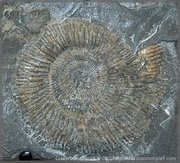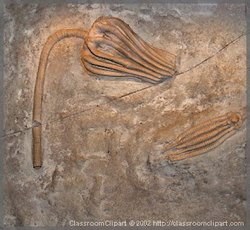Fossil
|
|
Fossils are the mineralized remains of animals or plants or other traces such as footprints. The totality of fossils and their placement in rock formations and sedimentary layers (strata) is known as the fossil record. The study of fossils is called paleontology.
The word fossil is derived from the Latin word fossilis, which means "to be dug up".
Fossilization is actually a rare occurrence because natural materials tend to be recycled. In order for an organism to be fossilized, the remains normally need to be covered by sediment as soon as possible. However there are exceptions to this, such as if an organism becomes petrified or comes to rest in an anoxic environment such as at the bottom of a lake. There are several different types of fossils and fossilization processes.
Fossils usually consist of traces left by the remains of the organism itself. However, fossils may also consist of the marks left behind by the organism while it was alive, such as the footprint of a dinosaur or reptile. These types of fossil are called trace fossils.
The oldest known structured fossils are most likely stromatolites. Believed to be formed by the entrapment of minerals by mucous-like sheets of cyanobacteria, the oldest of these formations dates from 3.5 billion years ago. Fossilized deposits of heavy carbon (acritarchs) that are also indicative of earlier life (3.8 billion years ago) are currently proposed as the remains of the earliest life on Earth.
| Contents |
Permineralization
Permineralization consists of organic remains turning into stone. The organism gets covered by sediment soon after death or after the initial decaying process. The degree to which the remains are decayed when covered determines the later details of the fossil. Some fossils only consist of skeletal remains or teeth; other fossils contain traces of skin, feathers or even soft tissues. Once covered with sediment, these layers slowly compact to rock, after which the chemicals in the remains are slowly replaced with hard minerals.
Although the original chemical composition of the organism has entirely vanished, the mineralization process proceeds differently for different kinds of tissues, and microscopic details of internal bone structure may be preserved.
Not all dead plants or animals turn into fossils. The youngest fossils, except for certain special cases like freezing or preservation in tar pits, are believed to be at least 10,000 years old. [1] (http://clearlyexplained.com/nature/earth/minerals/fossils.html)
Mould, cast and trace fossils
If percolating water dissolves the remains of an organism, and thereby leaves a hole in the matrix rock, the result is called a mould fossil. If this hole is filled with more minerals, it is called a cast fossil. If the burial of the organism was rapid, then chances are that even impressions of soft tissues remain. Trace fossils are the remains of trackways, burrows, footprints, eggs and egg-shells, nests and droppings. The latter, called coprolites, can give insight in the feeding behavior of animals and can therefore be of great importance.
Resin fossils
Smaller animals, insects, spiders and small lizards can be trapped in resin (amber), which is secreted from trees. These fossils can be found in sandstones or mudstones or washed up on beaches like those around the Baltic Sea.
Pseudofossils
Pseudofossils are regular patterns in rocks that are produced by naturally occurring processes. They can easily be mistaken for real fossils. Some pseudofossils, such as dendrites, are formed by naturally occurring fissures in the rock that get filled up by percolating minerals. Other types of pseudofossils are kidney ore (round shapes in iron ore) and moss agates, which look like moss or plant leaves. Concretions, round or oval-shaped nodules found in some sedimentary strata, were once thought to be dinosaur eggs, and are often mistaken for fossils as well.
Living fossils
Living fossil is a term used for any living species which closely resembles a species known from fossils, i.e., as if the fossil had "come to life". This can be a species known only from fossils until living representatives were discovered, such as the Coelacanth, or a single living species with no close relatives, such as the Horseshoe crab, that is the sole survivor of a once large and widespread group in the fossil record.
See also
- Acritarchs
- Collecting fossils
- Fossils and the geological timescale
- Fossil fuels
- Prehistoric life
- Transitional fossil
External links
- The Virtual Fossil Museum throughout Time and Evolution (http://www.fossilmuseum.net/index.htm)



